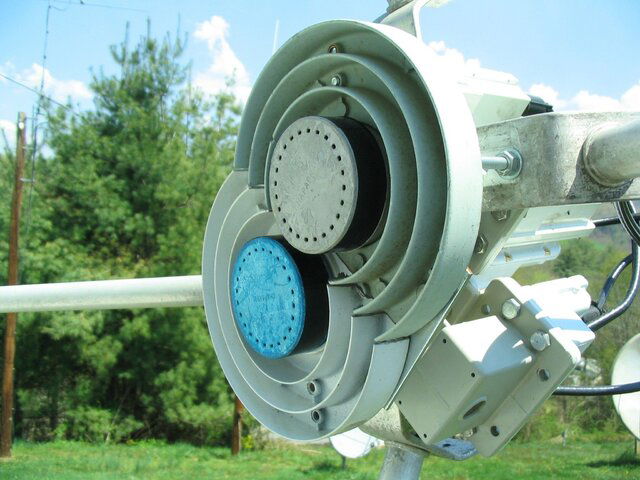Me too...here's mine...i have copied the great pendragons concept...
crackt out,.
C-band Linear/Circular Orthomode Feed Modification
- Thread starter pendragon
- Start date
- Latest activity Latest activity:
- Replies 28
- Views 15K
You are using an out of date browser. It may not display this or other websites correctly.
You should upgrade or use an alternative browser.
You should upgrade or use an alternative browser.
- Status
- Please reply by conversation.
Me too...here's mine...
is that 2 chaparal orthos in the pic? im assuming a dielectric is needed in one ?
crackt out,.
is that 2 chaparal orthos in the pic? im assuming a dielectric is needed in one ?
crackt out,.
Yep...2 Chaparral orthos with a plate in the upper one. This dish has a left hand mounted actuators so the linear can see a bit farther west and the circular can see a bit farther East. I can see down to Express AM44 at 11 West.
Yep...2 Chaparral orthos with a plate in the upper one. This dish has a left hand mounted actuators so the linear can see a bit farther west and the circular can see a bit farther East. I can see down to Express AM44 at 11 West.
will the chaparrel corotor II wideband feed perform the same way as your setup?
I wouldn't know as I have never played with a wideband Corotor. I deleted the message above this because I thought you were talking about mounting 2 wideband Corotors in siamese configuration...will the chaparrel corotor II wideband feed perform the same way as your setup?
will the chaparrel corotor II wideband feed perform the same way as your setup?
the corotor wideband feed is a different solution to the problem the siamese ortho setup solves. the main differences between it and the siamese are...
- the siamese setup can feed more than one reciever at a time.
- the wideband corotor needs a reciever capable of setting 4 polarizer positions.
umm and i think pendragon has stated that an orthomode feed performs better than a corotor feed. i thinks thats about all i can think of.
crackt out,.
the corotor wideband feed is a different solution to the problem the siamese ortho setup solves. the main differences between it and the siamese are...
- the siamese setup can feed more than one reciever at a time.
- the wideband corotor needs a reciever capable of setting 4 polarizer positions.
umm and i think pendragon has stated that an orthomode feed performs better than a corotor feed. i thinks thats about all i can think of.
crackt out,.
ok thanks. . .why i ask is because im usin the chaparrel wideband feed and it performs 'ok' i would say 'ok' is because i have nothing to compare it to.
i dont need it to hook to a million receivers as its only me who will watch anything on the bud
as for performin better, what difference would i see if i where to use one of this bad boy feeds?
thanks guys
as for performin better, what difference would i see if i where to use one of this bad boy feeds?
I've not seen a direct performance shoot-out between these feeds, however I've corresponded publicly and privately with a number of people who have done some form of testing between the available C-band feeds. The composite of this and published specifications leads at best to a coarse estimate of the relative performance of a wideband corotor with the dielectric inserted vs. the two single ortho feeds I used.
For the linear side, a wideband corotor without a dielectric plate delivers about 1 dB less CNR than single linear ortho feed. Inserting the plate causes a further 0.5-1 dB loss. On the circular side, a high-end circular feed like the ADL will outperform a single ortho with a dielectric plate by about 1 dB, and and that will outperform a corotor with a plate by another 1 dB. The losses are therefore between 1-2 dB for both sets of polarization.
Translated into other terms, let's say one has a 10' dish with a corotor plus a dielectric plate. A 1 dB loss means the dish will perform in CNR the same as a 8' dish with a single ortho feed. A 2 dB loss means the dish will perform in CNR the same as a 6.5' dish with a single ortho feed. CNR is important for C-band reception, but it isn't everything. Separating an adjacent orbital position 2 degrees away is also important and a 10' dish will do this the same regardless of the feeds listed here. Whether CNR is critical to your needs depends a lot on your viewing preferences. If you're after weak, near the horizon, high rate, high FEC and/or DVB-S2 signals, a better feed can make a big difference.
ah ok. . .thanks guy, im not sure what CNR is but i will look it up, so far my wide band feed works and gets me the TPs im after with high quality where possible, so im happy. 
- Status
- Please reply by conversation.
Similar threads
- Replies
- 8
- Views
- 1K
- Replies
- 0
- Views
- 388
- Replies
- 2
- Views
- 251
- Replies
- 34
- Views
- 2K




